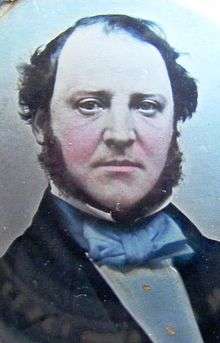Sampson Moore


Sampson Moore (1812-1877) was an engineer of the Industrial Revolution based in Liverpool, England. His company, Sampson Moore & Co. produced a number of notable inventions.
Overview
Moore (1812-1877) was an engineer based in Liverpool. His company, Sampson Moore & Co. specialised in casting large iron structures and ownded North Foundry in Gt Howard Street Liverpool. Sampson Moore & Co. supplied mortars for the Royal Navy[1] and goods were shipped overseas on the 105 ft wooden steamship, the SS James Dennistoun.[2] In 1876 Sampson Moore designed and supplied the first ever electric overhead crane, which was used to hoist guns at the Royal Arsenal in Woolwich, London.[3] Specifically he patented the improved winch mechanism that allowed the lifting of heavier weights (such as naval guns) by an electric motor.[4] Electric overhead cranes were subsequently installed in several foundries in the north of England and were considered one of many technical advancements of the British Industrial Revolution.[5] The invention was celebrated in the Opening Scene of the London 2012 Olympics, where an electric overhead crane lifted cast Olympic rings out of a staged foundry in the Pandemonium scene.[6] Other notable inventions included a machine for rolling tobacco[7] and machines for rolling and polishing rice.[8][9]
Violin Collection
Moore was also well known as a collector of violins. Several of Moore's instruments were included in the "Special Exhibition" of musical instruments in London in 1872.[10] These included violins by Landolfi made in 1776 and a Richard Duke violin from 1756.[11] The exhibition was chaired by Prince Alfred, the Duke of Edinburgh,[12] who was himself a keen violinist and subsequently Sampson Moore supplied Prince Alfred with several instruments. In 1874 he located two violins which had belonged years earlier to the Prince's late uncle the Duke of Cambridge, for which Alfred was particularly appreciative.[13]
Personal life
Sampson Moore married Elizabeth Grindle (b. 1806) on 20 Jun 1833 at the church of St Peter in Liverpool. They had one daughter, Elizabeth Moore (b. 1834) and one son, Stanley Moore, who was living in Tasmania at the time of his father's death.[14]
References
- ↑ Royal Navy Circular No 1, sent by Inspector of Machinery's Office, Royal Arsenal, Woolwich 14 June 1855
- ↑ Shipping Times, Clydebuilt database 2002
- ↑ "Overhead power travelling crane for the Gun Factory of the Royal Arsenal" The Engineer, 22 September 1876, p219
- ↑ The London Gazette, 1 Feb 1867 (original patent filed on 25 Jan 1854)
- ↑ Yorke, Stan (2005) The Industrial Revolution Explained: Steam, Sparks and Massive Wheels (England's Living History) Countryside Books, ISBN 978-1853069352
- ↑ BBC News report on London Olympics Opening Ceremony
- ↑ The London Gazette, 28 March 1862 (patent 766, page 1687)
- ↑ The London Gazette, 24 Sept 1861 (patent 1423, page 3832)
- ↑ The London Gazette, 21 June 1861 (patent 1423, page 2592)
- ↑ "Catalogue of the Special Exhibition of Ancient Musical Instruments" by George A. Dissmore and Charles Reade, South Kensington Museum (1872)
- ↑ "The Violin Family and its Makers in the British Isles" by Brian W Harvey, Clarendon Press, Oxford, 1995. pp 183-185
- ↑ "Catalogue of the Special Exhibition of Ancient Musical Instruments" by George A. Dissmore and Charles Reade, South Kensington Museum (1872)
- ↑ Letter from HRH the Duke of Edinburgh to Sampson Moore, sent by Arthur B Haig, Equerry, postmarked 8 May 1874
- ↑ The Mercury Newspaper, Hobart, Tasmania, Volume XXX Number 5125, 19 March 1877